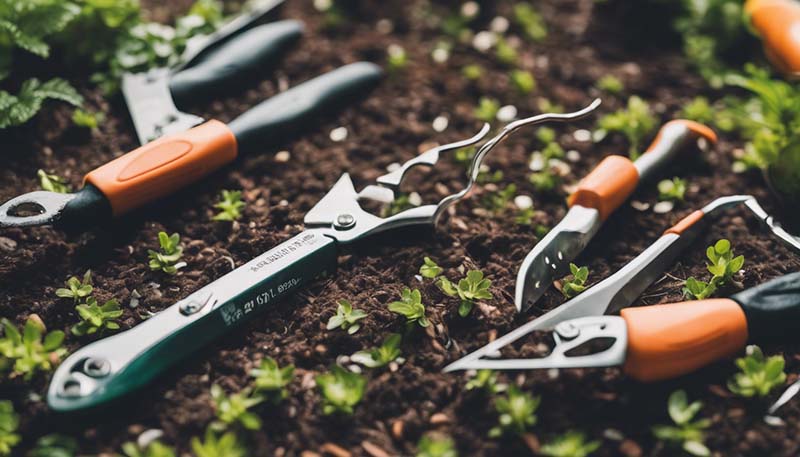The Ultimate Guide to Gardening Tools for Pruning and Training
The Ultimate Guide to Gardening Tools for Pruning and Training
Gardening is a rewarding and fulfilling hobby that allows you to connect with nature and enjoy the fruits of your labor. Pruning and training are essential techniques that help maintain the health and appearance of your plants. In this ultimate guide, we will explore the various gardening tools designed specifically for pruning and training, their uses, and how to choose the right one for your needs.
**Introduction to Pruning and Training**
Pruning is the process of cutting away dead, damaged, or excess growth from plants to promote healthy growth and maintain their shape. Training, on the other hand, involves guiding and shaping the growth of plants through various methods, such as staking, tying, or weaving.
**Why Pruning and Training are Important**
1. **Health**: Pruning removes diseased or dead parts of the plant, preventing the spread of diseases and pests.
2. **Growth**: It encourages new growth and can help plants grow in a more controlled and desired direction.
Advertisement
3. **Aesthetics**: Training shapes plants to be more visually appealing and can be used to create specific structures like topiary.
4. **Flowering and Fruiting**: For fruit trees and flowering plants, pruning can increase yield and the number of blooms.
**Types of Pruning and Training Tools**
1. **Pruning Shears**: These are essential for cutting small to medium branches. Look for bypass or anvil types, with the former being better for clean cuts.
2. **Loppers**: Larger than pruning shears, loppers are designed for thicker branches. They come in both straight and curved varieties.
3. **Pruning Saws**: For cutting through larger branches, pruning saws are a must. They are available in different sizes and styles, such as folding or bow saws.
4. **Secateurs**: These are smaller, handheld tools for pruning small stems and twigs. They are perfect for precision pruning.
5. **Hedge Trimmers**: For trimming hedges and topiary, hedge trimmers come in both manual and powered forms.
6. **Training Tools**:
- **Stakes**: Used to support and guide the growth of plants.
- **Ties**: Soft ties made of twine, cloth, or plastic are used to secure plants to stakes without causing damage.
- **Trellises**: Structures that provide support for climbing plants.
7. **Specialized Tools**:
- **Cane Cutters**: Designed for cutting thick canes found in bamboo or cane plants.
- **Grafting Tools**: A set of tools used for grafting, a technique to join two plants together.
**Choosing the Right Tool**
When selecting pruning and training tools, consider the following factors:
1. **Type of Plant**: Different plants require different tools. For example, fruit trees may need a larger saw, while roses could be pruned with secateurs.
2. **Size and Strength**: Choose tools that match your physical capabilities. Heavy-duty tools can be tiring for extended use.
3. **Sharpness**: Dull tools can damage plants and make the job more difficult. Always keep your tools sharp.
4. **Quality**: Invest in high-quality tools that are made to last. Cheap tools may break or become ineffective over time.
5. **Safety**: Ensure that the tools have safety features like ergonomic handles and locking mechanisms.
**Using Pruning and Training Tools**
1. **Pruning Shears**: Use them for branches up to about ¾ inch in diameter. Make clean, angled cuts to avoid tearing the bark.

2. **Loppers**: For thicker branches, use loppers. Stand so that the branch you\'re cutting does not fall on you.
3. **Pruning Saws**: Use for larger branches. Always cut at an angle to prevent water from collecting on flat cuts.
4. **Secateurs**: Perfect for deadheading flowers and trimming small branches. Always cut at a 45-degree angle above a bud.
5. **Training**: When training, be gentle to avoid damaging the plant. Use ties to guide growth without constricting the stem.
**Maintaining Your Tools**
1. **Cleaning**: After use, clean your tools to remove any dirt or plant residue. This prevents the spread of diseases and rust.
2. **Sharpening**: Regularly sharpen your tools to ensure they remain effective.
3. **Storage**: Store your tools in a dry place. For shears and secateurs, the blades should be oiled to prevent rust.
4. **Inspection**: Before each use, inspect your tools for any signs of damage or wear.
**Conclusion**
Pruning and training are vital aspects of gardening that not only improve the health and appearance of your plants but also offer a sense of satisfaction and accomplishment. With the right tools and techniques, you can transform your garden into a beautiful, well-maintained space. Remember, the key to successful pruning and training lies in understanding your plants\' needs and choosing the appropriate tools for the job. Happy gardening!
**Note**: This guide provides a comprehensive overview of pruning and training tools, their uses, and how to maintain them. For a more in-depth exploration or specific techniques, consider consulting with a local horticulturist or taking a gardening course.
Comment